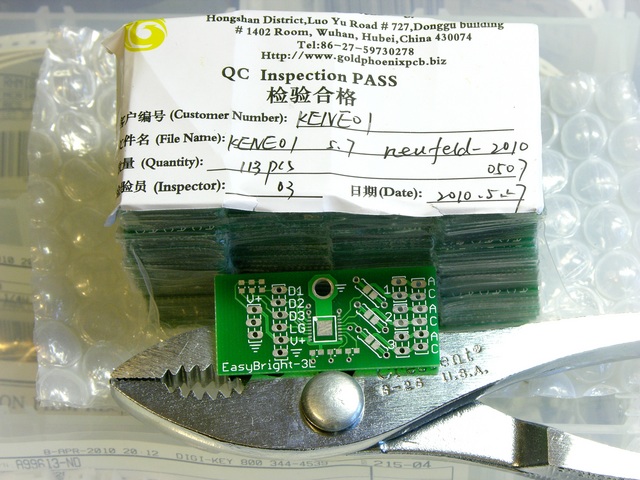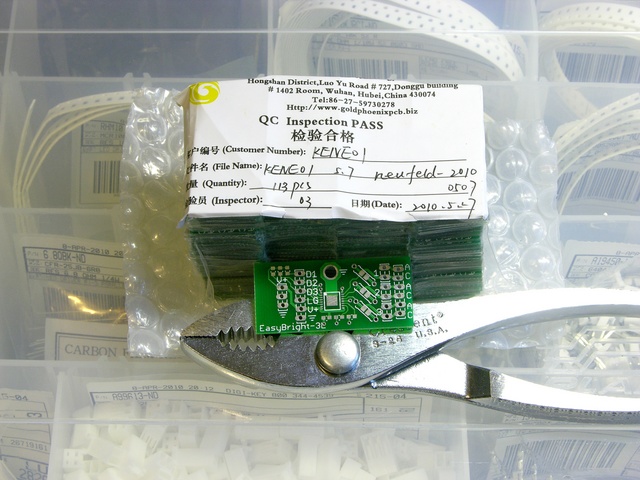Two and a half weeks ago, I finished up the CAM files for my first set of EasyBright LED driver PC boards and sent them off to have boards made.
While shopping around for board houses, I had narrowed my choices to two. Here’s how I made the final selection of Gold Phoenix — not, as it turns out, whom I thought at first I was going to pick.
PCB Express
PCB Express was initially my strongest contender. They offer a range of options, including copper only (no solder mask or silkscreen), two-layer with silkscreen, and four- and six-layer boards. They also partner with Screaming Circuits (read their blog for amazingly insightful, real-world ruminations on how to [and not to] design boards for manufacturability) for PCB assembly — something I don’t need now but might want in the future.
PCB Express’s pricing is a matrix of board size and quantity, with pretty appealing prices for moderate quantities of largish boards. They don’t mind if you panelize (tile a plane with multiple copies of your board — some board houses refuse to accept panelized orders) and will even route perforated lines to break apart your smaller boards, but won’t route complete cuts to separate your boards for you.
The EasyBright came out to be 1.75″ x .8″, and I wanted either about twenty (test/samples) or about a hundred (first production run) of them. My “E2″ order would have cost $166 to get two boards without panelization and with double-sided silkscreening ($83 per board) or the same $166 to get 12 panelized boards that I’d have to break apart ($13.83 per board). $478 would get me 90 panelized boards, again with double-sided silk — about $5.31 per board.
Gold Phoenix
Gold Phoenix was my underdog, in part because I hadn’t studied their pricing and capabilities closely enough. They have a prototype offer of 100 square inches for $100 or 155 square inches for $110 — each for two-sided boards with solder mask and top silkscreening. This rate includes shipping.
It also includes free “step and repeat” — that is to say, they will automatically panelize your design for you; and although this took me a while to figure out for sure, they cut them apart for you, too. Bottom-side silkscreen is an additional $20, as is electrical testing to discard boards with manufacturing defects impacting the copper connections.
So for $130, I could get 155 square inches worth of boards, plus $20 for electrical testing so I didn’t have to worry about clinkers. I guesstimated a kerf of .1″ to cut apart the boards, so the 10″ x 14.5″ panel they mention should give me 11 x 7 = 77 or 5 x 16 = 80 boards — in the neighborhood of $1.88 per board. That sounded fantastic!
Ordering from Gold Phoenix
To place my order, I ran an EAGLE CAM export and zipped up the files along with an index listing what layer each file represented. I then emailed the zip file to goldphoenixtech@yahoo.ca, indicating that I wanted 155 square inches of panelized boards with standard PCB material and copper weight, green solder mask, and double-sided silkscreen.
I got back a prompt quote for 110 boards instructing me to PayPal them, which I did, and my order was underway. 110 boards — obviously they cut the boards apart with a smaller kerf than I had envisioned.
And then after my order was placed, Asmodeus noticed that I had dropped a trace on one of the current-sense resistors while I was playing with eagle3d. Drat!
I quickly corrected the mistake in EAGLE and emailed Gold Phoenix asking whether they could restart the process with my fixed file. They had already “processed the job,” but for a $50 fee were willing to start over. That was a no-brainer — 110 boards I’d have to fix by hand or fifty bucks to fix them — so I sent the money and they started over.
Boards from Gold Phoenix
Just over a week later, they sent me a note indicating that my boards had shipped, and I received the package a few days after that.
113 adorable little boards, all cut apart and stacked and sealed up in plastic (and packed carefully in a box, not shown here). Woo-hoo!
Wait, 113 boards? I was estimating 77 to 80, they quoted me 110, and they delivered 113? What’s up with that???
Entirely ignoring the kerf and envisioning the 10″ x 14.5″ panel they list as their maximum size,, the .8″ x 1.75″ boards could fit 12 x 8 = 96 one way or 18 x 5 = 90 boards the other way. Neither one of these gets me 110 boards, much less 113.
Let’s go about this another way. 113 is prime; so if we assume that they made me a single rectangular panel, they must have discarded some boards after electrical testing. How would nearby numbers factor and what panel sizes would that imply?
- 114 boards = 6 * 19
6 * 1.75″ = 10.5″ and 19 * .8″ = 15.2″
10.5″ x 15.2″ = 159.6 sq-in (plus kerfs) - 115 = 5 * 23
23 * .8″ = 18.4″, which I rule out since they claim the maximum dimension is 14.5″ - 116 = 4 * 29, which gets us nowhere useful
- 117 boards = 9 x 13
9 * 1.75″ = 15.75″ and 13 * .8″ = 10.4″
15.75″ x 10.4″ = 163.8 sq-in, which is quite a bit larger than promised
So I don’t know quite what to think — other than that I like getting 113 boards at $1.33 each (plus my $50 screwup).
Quality
All of the boards I’ve examined look really good, and I was delighted with the legibility of the silkscreen and my fairly small type. The top-side silkscreen registration was low by about .01″ (click one of the pictures above), which makes a bigger difference to the appearance of the board than you might guess, but it’s quite acceptable.
A sample board measures .796″ x 1.748″ — certainly close enough for me. Its upper left corner is cut in a bit of a diagonal, I’m guessing the last place the router touched when it cut loose. I should point out that I’m mentioning every little thing I’ve noticed while looking at the board with a critical eye for several days.
All in all, I’m tremendously pleased.


I use Gold Phoenix for every personal project I may have. It’s a lot cheaper than the local fabs (in Brazil, that is), quicker and they are of better quality.
Also, they screwed up one time (swapped top and bottom layers). One email with a photo and about 24 hours later they sent me a new batch. Free. No questions asked.
I used to run BatchPCB from panelization to shipping and we used Gold Phoenix for all but one month when we tried out Advanced Circuits. I can tell you that there are some bizarre things that would happen to panels that we sent. I am pretty sure they reorganized the panels I sent them as there were missing boards that were very similar to boards that were doubled up. About 80% of the panels were doubled by GP. I have a few guesses why you received an odd number of boards. 1:) that they added test coupons and other fab-house needed areas but that those areas did not take up a whole row or column of your boards and so the area was filled-in. 2:) They had another order for some big boards that your boards could fit in-between. In either case, it is pretty safe to err on the side of too many boards than not enough and having to re-run a whole panel just for a few boards.
Another way you can get a prime number of small rectangles out of a big rectangle is, if after tiling the big rectangle with the small rectangles, there’s a strip left over that’s not wide enough for the long dimension but is for the short dimension — so more can be added there, and not all of the boards are in the same orientation.
Kevin, excellent point! Going a step further, there might be other combinations of “horizontal” and “vertical” tiling that would fit more tiles than a single row or column of leftovers — although it seems less likely that Gold Phoenix would have gone to that much trouble. I can believe they’d add a single extra column, though.
I used Gold Pheonix for my AVR HV Rescue Shields and I was very happy with the results.
Thanks to Keith, I went directly to Gold Phoenix for my first job shopped out to a board house in about 15 years. I usually fabricate boards in my basement, but this one was just more than I could reasonably accommodate. Thanks to the VERY WELL written evaluation of service from Keith, I was able to make a MUCH better choice. Thanks Keith — I know you hear this a lot, but the clear, concise write-up saved me a lot of time and money in the end.